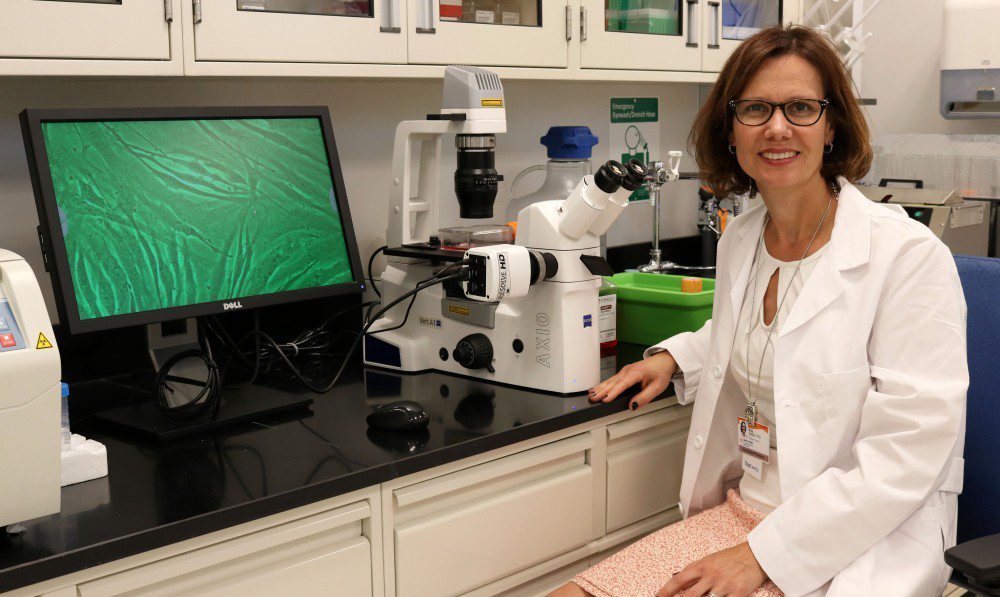
Dr. Rita Sattler’s PhD Research Paved Way for Promising Stroke Drug
Research suggests the average person loses 1.9 million neurons every minute a large vessel ischemic stroke goes untreated, increasing the risk of lasting neurological deficits. Stroke is the leading cause of adult disability in the United States.
Investigators presented the results of the ESCAPE-NA1 trial at the latest International Stroke Conference. Dr. Rita Sattler, an associate professor of neurobiology at Barrow, attended the meeting to hear the announcement.
“It was an incredible achievement to show that this worked, and it took 20 years to get to this point,” she said.
Although Dr. Sattler now focuses primarily on researching neurodegenerative diseases, she studied the pathway in the brain targeted by this neuroprotective drug as a PhD student in the 1990s. The discoveries made by Dr. Sattler and her team at the University of Toronto helped to pave the way for the clinical trial.
“This is a wonderful example of the overlapping research we strive for at Barrow, with basic research moving through translational stages and into clinical trials,” said Dr. Michael Waters, director of the Barrow Stroke Program.
Trial Produces Unexpected Results, But Still ‘a Win’
In this Phase III trial, investigators sought to determine whether treatment with the drug nerinetide would improve outcomes for people with ischemic stroke due to large vessel occlusion who also underwent endovascular thrombectomy.
An ischemic stroke occurs due to a clot rather than a bleed. The most deadly ischemic strokes involve a blockage in a major artery, known as large vessel occlusion strokes. Endovascular thrombectomy is a minimally invasive treatment for this type of stroke. It involves navigating tiny instruments through the blood vessels in the body to remove the clot in the brain.
The trial randomly assigned patients to a single dose of nerinetide or placebo, and all participants underwent thrombectomy. It further grouped patients by whether or not they received the clot-busting drug tPA and the device used in their thrombectomy: a stent retriever or an aspiration device. Creating these groups accounted for the possibility of drug-drug and drug-device interactions.
Patients received tPA (alteplase) based on national or regional guidelines for stroke care, either before or during endovascular treatment.

Associate Professor of Neurobiology
Nerinetide did not show neuroprotection in all patients treated with the drug when compared with placebo. However, it was associated with improved outcomes in those who did not receive tPA.
“The magnitude of effect of alteplase was not predicted,” the authors wrote. “A better design would have been to run two parallel trials comparing nerinetide with placebo, one with alteplase and another with no alteplase. However, such an approach was probably premature, given the state of knowledge at the time.”
Confirming this finding and understanding the possible interaction between alteplase and nerinetide will require further research. However, the results of the trial are promising for patients with stroke and perhaps patients with other neurological diseases. Evidence suggests the pathway targeted by this drug may be involved in neurodegenerative diseases like ALS.
“The fact that there was increased survival in these patients, increased improvements in these patients, that’s definitely a win,” Dr. Sattler said. “The fact that a neuroprotectant shows efficacy in stroke patients, that really has not happened before.”
Understanding Cell Death in Stroke—and Stopping It
Nerinetide interrupts a signaling pathway in the brain involving the NMDA receptor and a protein known as post-synaptic density 95 (PSD-95). This pathway is critical in stroke, according to the research performed by Dr. Sattler and her team at the University of Toronto.
Cells in the brain communicate with each other through chemical messengers called neurotransmitters. Protein molecules on the surface of cells, known as receptors, receive these messages. Different neurotransmitters bind to and activate specific receptors, like a key fitting into a lock.
A neurotransmitter called glutamate activates NMDA receptors. Helping to anchor this receptor to the surface of the cell so that it can receive glutamate is one of the functions of the PSD-95 protein. This protein is also responsible for connecting the receptor to important signaling molecules within the cell.
During a stroke, however, glutamate overactivates NMDA receptors. In return, due to the proximity of the receptor to a specific enzyme via its connection to PSD-95, too much nitric oxide is produced. This becomes toxic to neurons and contributes to their death.
Based on this finding, Dr. Sattler and her team explored ways in the laboratory to reduce or eliminate PSD-95. They found that when they were able to decrease the presence of PSD-95 to 20 percent of its usual levels in a cell, they were able to protect the cell from toxicity and death.
Hard Work and a Little Luck
Dr. Sattler came to Barrow because the proximity of the laboratories to the clinic provides an optimal environment for translating scientific research to clinical treatment. She continues to study glutamate receptors but mainly in the context of ALS and frontotemporal dementia.
Most of it comes from working hard, working smart, being patient, and being motivated to try over and over again.
-Dr. Rita Sattler, Associate Professor of Neurobiology
With research suggesting that glutamate receptor dysfunction also plays a role in ALS and other diseases, she’s interested in exploring potential applications of nerinetide outside of stroke.
Dr. Sattler also heads the Summer Undergraduate Research Program at the Institute, helping to provide and coordinate invaluable mentorship and hands-on laboratory experience for aspiring neuroscientists.
She hopes the news that her graduate research has translated to a late-stage clinical trial reminds her students of what’s possible with a little luck and a lot of persistence.
“Most of it comes from working hard, working smart, being patient, and being motivated to try over and over again,” she said.
